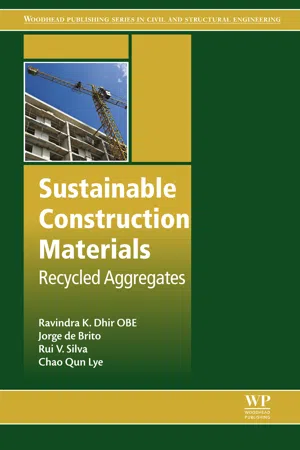
Sustainable Construction Materials
Recycled Aggregates
- 652 pages
- English
- ePUB (mobile friendly)
- Available on iOS & Android
Sustainable Construction Materials
Recycled Aggregates
About This Book
Sustainable Construction Materials: Recycled Aggregate focuses on the massive systematic need that is necessary to encourage the uptake of recycled and secondary materials (RSM) in the construction industry. This book is the fifth and the last of the series on sustainable construction materials and like the previous four, it is also different to the norm. Its uniqueness lies in using the newly developed, Analytical Systemisation Method, in building the data-matrix sourced from 1413 publications, contributed by 2213 authors from 965 institutions in 67 countries, from 1977 to 2018, on the subject of recycled aggregate as a construction material, and systematically analysing, evaluating and modelling this information for use of the material as an aggregate concrete and mortar, geotechnics and road pavement applications. Environmental issues, case studies and standards are also discussed. The work establishes what is already known and can be used to further progress the use of sustainable construction materials. It can also help to avoid repetitive research and save valuable resources. The book is structured in an incisive and easy to digest manner and is particularly suited for researchers, academics, design engineers, specifiers, contractors, and government bodies dealing with construction works.
- Provides an exhaustive and comprehensively organized list of globally-based published literature spanning 5000 references
- Offers an analysis, evaluation, repackaging and modeling of existing knowledge that encourages more responsible use of waste materials
- Provides a wealth of knowledge for use in many sectors relating to the construction profession, including academia, research, practice and adoption of RSM
Frequently asked questions
Information
Introduction
Synopsis
Keywords
1.1. Background
- • A study undertaken by Silva et al. (2014a) has provided a method for classifying recycled aggregates (RAs) derived from construction demolition waste for use in concrete, which could help with their certification and boost stakeholders’ confidence in their use. The same authors have produced a series of further studies assessing the effect of using RAs in concrete and geotechnical applications (Silva et al., 2014b, 2015a,b,c, 2016a,b, 2017a,b).
- • A series of studies aimed at assisting the design engineer in adopting the use of sustainable construction materials, within the framework of existing design codes such as Eurocode 2 (2004), has been published by Lye at el. (2015a,b, 2016a,b,c,d, 2017). This work assessed the effects of coarse recycled concrete aggregate, glass cullet as a fine aggregate and copper slag as a fine aggregate on the modulus of elasticity, creep and shrinkage of concrete.
- • On the carbonation, chloride ingress and associated corrosion of steel reinforcement in concrete made with cement incorporating fly ash, ground granulated blast-furnace slag and ground limestone, complying with the European standard EN 197-1 (2011), the analysis and evaluation of global data have revealed some challenging facts about the performance of concrete and the accompanying impacts on sustainability that had hitherto not generally been appreciated (Lye et al., 2015b, 2016d; Elgalhud et al., 2017a,b).
- • Similarly, in the area of incinerated ashes, a series of studies has been undertaken using the analytical systematisation method in characterising sewage sludge ash and municipal incinerated bottom ash and assessing their environmental impacts and potential for use as components of cement or aggregate in mortar and concrete, geotechnics, road pavements and ceramic applications (Lynn et al., 2015, 2016a,b,c, 2017a,b).
Table of contents
- Cover image
- Title page
- Table of Contents
- Related titles
- Copyright
- Dedication
- Author Profiles
- Preface
- 1. Introduction
- 2. Methodology
- 3. Availability of Recycled Aggregates
- 4. Processing of Recycled Aggregates
- 5. Properties and Composition of Recycled Aggregates
- 6. Use of Recycled Aggregates in Mortar
- 7. Fresh Concrete Properties
- 8. Strength Development of Concrete
- 9. Deformation of Concrete Containing Recycled Concrete Aggregate
- 10. Recycled Aggregate Concrete: Durability Properties
- 11. Use of Recycled Aggregates in Geotechnical Applications
- 12. Use of Recycled Aggregates in Road Pavement Applications
- 13. Environmental Impact, Case Studies and Standards and Specifications
- 14. Potential for the Recycled Aggregate Market
- 15. Epilogue
- Index